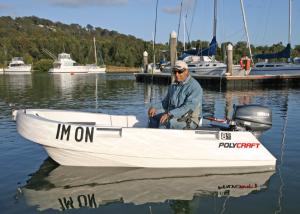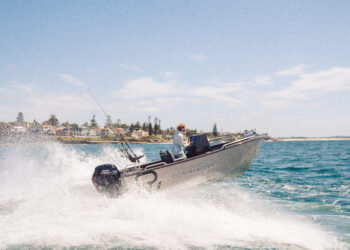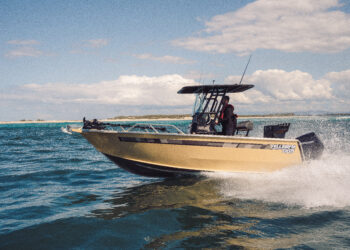Looking for a budget priced, easy-to-launch small boat that’s sure to get you out fishing more? Kevin Savvas might have found the craft for you.
THE need to get away from our 9 to 5 realities means more of us are looking for easier ways to get on the water. With rising financial pressures, those looking to enter the boating market are sometimes repelled by the expense associated with boats. The other consideration is space. Once you buy your boat where do you store it? You’d be surprised how many boaters struggle to store their craft at home successfully. I guess this is one of the reasons why kayak fishing has risen to prominence over the past few years. It ticks all the right boxes. Kayaks are relatively inexpensive to buy and maintain and are more easily stored than a boat. They can also get you into locations far away from the crowd. This increasing trend has created a niche market for those who want the convenience of a small, inexpensive craft like a kayak, but with the attributes and cockpit layout of a conventional dinghy. Polycraft looks to have answered this call with its nifty 3m Tuff Tender. As the name suggests, this little brute started its life as a tender but also nicely fits a more utilitarian purpose as a sneaky small water fishing boat – one with some not-so-small water capabilities.
The Tuff Tender features a tri-hull design which offers excellent stability, and Polycraft’s typical durable polyethylene dual skin. My Uncle Angelo and his good mate Robert each recently invested in one of these boats after a long process of elimination. The main consideration for buying their small poly boats was the easy maintenance, low cost and ease of storage. In fact, both of these hardcore fishos have bigger boats in the garage but wanted a small boat they could hitch up and launch on the spur of the moment. When you also factor in the time saving on post fishing wash down and clean up, small is definitely better. Fastidious owners like these two, during an impromptu two hour flick session would spend as much time afterwards washing their boat, making quick sessions hard to justify.
They were also looking to fish the upper limits of their local river, which in stages is far too shallow for a conventional tinny. This was vindicated with these boats having the ability to float in water less than 10cms. With the short shaft outboard leg fully down it still floated in water less than 25cm and planed in less than 15cm.
On the water
I recently had an opportunity to head out on Angelo’s boat and put it through its paces. From the outset I was very impressed with the soft ride for such a light (80kgs) hull. It was a pristine day out on Pittwater so we searched for boat wake to test out the handling. This was my first experience with a poly constructed boat. The ride is somewhat akin to my fibreglass boat in that hull slap was negligible and the boat felt stable and predictable. The hull performed beautifully over chop and cut through the water with ease, which was especially astounding given the boat’s lightness. Angelo remarked that the boat rode better with two passengers, as my weight on the front casting deck kept the nose down while planing. Apparently the nose porpoises a little with one on board. This isn’t so surprising when you consider the outboard, fuel tank and driver are all placed at the back of the boat. Weighted correctly, the boat planed very easily at a speed of around 10 knots. With a 15hp Yamaha two-stroke powering the boat, we hit 20 knots, which was quite impressive with the heavy load. Underway we put the little Polycraft into some tight figure-eight turns and it nearly threw me off the front deck. It cornered with a good horizontal attitude and resisted rolling thanks to the tri-hull. I likened it to driving a go-kart; the steering was super responsive and direct with no cavitation evident. As is customary for an open boat, wind spray did enter the boat, quarter on to the wind, but is less of an issue with one person on board as the nose sits higher while planing.
At rest, the Tuff Tender took a bit of getting used to. The boat rolls to one side until the outer hulls are engaged then the hull digs in and refuses to roll further. We tested it further by both standing on one gunwale and we couldn’t get it to tip past this lock-up point. This was a seriously impressive characteristic, considering our total weight of 180kgs and the diminutive size of the vessel. Even in chop it was manageable fishing two people standing up, casting lures. In fact, as the day wore on, it became easier the more I got used to the initial small roll.
To really test it out we headed to West Head at the mouth of the Hawkesbury River in a one metre swell, where a few pro lobster fishermen gave us more than an inquisitive stare. Three metre boats aren’t normally seen in that part of the world, but the Poly handled it with aplomb. In saying this, the boat is aimed squarely at more sedate areas and would be perfect for tight, shallow backwaters where two can fish in comfort. It’s actually rated for three people but I’m not sure where the third person rides?
The deck layouts on the test boats have been customised by both Angelo and Robert. The pics above show two different examples of how the boys have gone about it. Both examples show the type of fishing the boys are gearing up for; Robertino is fitting a Minn Kota electric to his boat very soon. In fact, apart from a live well, these little pocket rockets have everything an entry-level tournament boat does. Angelo tells me a live well is possible, although he chose to have storage hatches in both the rear quarters instead of live wells. A live well can also be fitted under the front casting deck. The aftermarket decking also means you can store your gear underfoot, so all available space can be used for fishing. Clutter in a boat is annoying but in a three-metre boat it can be hazardous.
As standard the Polycraft Tuff Tender comes with a moulded anchor well, cleat and stainless steel shackle to ensure easy towing, anchoring and mooring. Also included are two rod holders, rowlocks and a transom plate for mounting an outboard rated up to 15hp. The recessed stainless steel handles on the gunwales located amidships, designed for davits, make it easy for two people to carry, Both boys have their boats on Sea Trail trailers, but at 80kgs for the hull only they can easily be used as car toppers – handled by two people.
The boat itself retails for around $1800, with the total package as tested costing $5,200 without the additional casting decks and sounders. However, one thing Robertino said stuck in my mind as he waxed lyrical about his new toy: “It’s like a kayak on steroids”. Enough said!


















